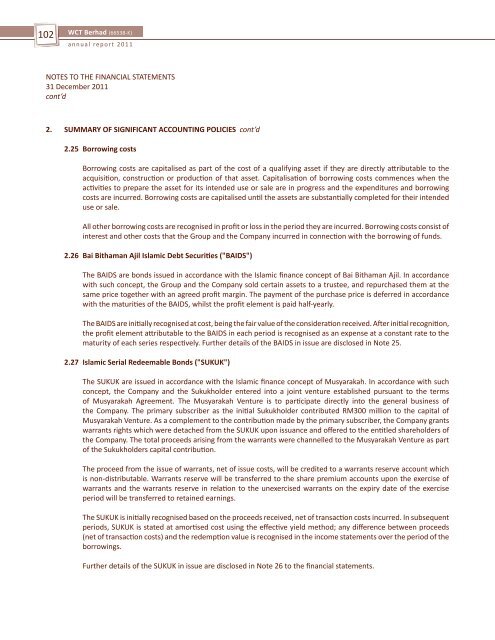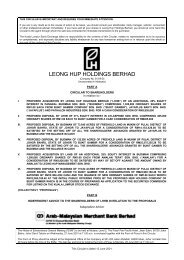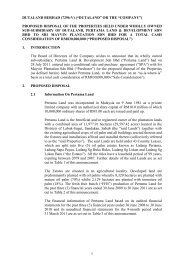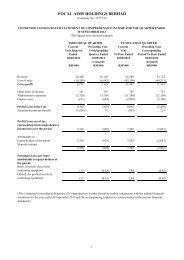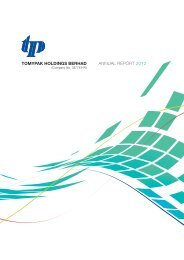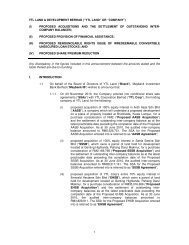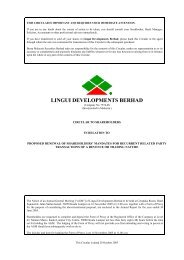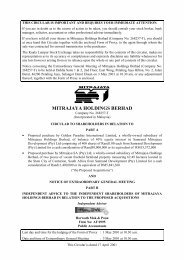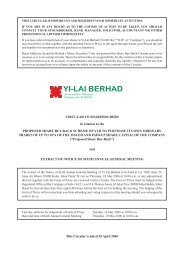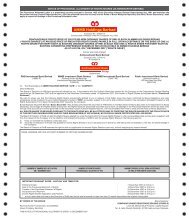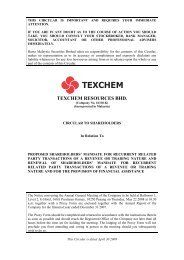WCT-Page 30 to ProxyForm (2.4MB).pdf - Announcements - Bursa ...
WCT-Page 30 to ProxyForm (2.4MB).pdf - Announcements - Bursa ...
WCT-Page 30 to ProxyForm (2.4MB).pdf - Announcements - Bursa ...
You also want an ePaper? Increase the reach of your titles
YUMPU automatically turns print PDFs into web optimized ePapers that Google loves.
102<br />
<strong>WCT</strong> Berhad (66538-K)<br />
annual report 2011<br />
NOTES TO THE FINANCIAL STATEMENTS<br />
31 December 2011<br />
cont’d<br />
2. SUMMARY OF SIGNIFICANT ACCOUNTING POLICIES cont’d<br />
2.25 Borrowing costs<br />
Borrowing costs are capitalised as part of the cost of a qualifying asset if they are directly attributable <strong>to</strong> the<br />
acquisition, construction or production of that asset. Capitalisation of borrowing costs commences when the<br />
activities <strong>to</strong> prepare the asset for its intended use or sale are in progress and the expenditures and borrowing<br />
costs are incurred. Borrowing costs are capitalised until the assets are substantially completed for their intended<br />
use or sale.<br />
All other borrowing costs are recognised in profit or loss in the period they are incurred. Borrowing costs consist of<br />
interest and other costs that the Group and the Company incurred in connection with the borrowing of funds.<br />
2.26 Bai Bithaman Ajil Islamic Debt Securities ("BAIDS")<br />
The BAIDS are bonds issued in accordance with the Islamic finance concept of Bai Bithaman Ajil. In accordance<br />
with such concept, the Group and the Company sold certain assets <strong>to</strong> a trustee, and repurchased them at the<br />
same price <strong>to</strong>gether with an agreed profit margin. The payment of the purchase price is deferred in accordance<br />
with the maturities of the BAIDS, whilst the profit element is paid half-yearly.<br />
The BAIDS are initially recognised at cost, being the fair value of the consideration received. After initial recognition,<br />
the profit element attributable <strong>to</strong> the BAIDS in each period is recognised as an expense at a constant rate <strong>to</strong> the<br />
maturity of each series respectively. Further details of the BAIDS in issue are disclosed in Note 25.<br />
2.27 Islamic Serial Redeemable Bonds ("SUKUK")<br />
The SUKUK are issued in accordance with the Islamic finance concept of Musyarakah. In accordance with such<br />
concept, the Company and the Sukukholder entered in<strong>to</strong> a joint venture established pursuant <strong>to</strong> the terms<br />
of Musyarakah Agreement. The Musyarakah Venture is <strong>to</strong> participate directly in<strong>to</strong> the general business of<br />
the Company. The primary subscriber as the initial Sukukholder contributed RM<strong>30</strong>0 million <strong>to</strong> the capital of<br />
Musyarakah Venture. As a complement <strong>to</strong> the contribution made by the primary subscriber, the Company grants<br />
warrants rights which were detached from the SUKUK upon issuance and offered <strong>to</strong> the entitled shareholders of<br />
the Company. The <strong>to</strong>tal proceeds arising from the warrants were channelled <strong>to</strong> the Musyarakah Venture as part<br />
of the Sukukholders capital contribution.<br />
The proceed from the issue of warrants, net of issue costs, will be credited <strong>to</strong> a warrants reserve account which<br />
is non-distributable. Warrants reserve will be transferred <strong>to</strong> the share premium accounts upon the exercise of<br />
warrants and the warrants reserve in relation <strong>to</strong> the unexercised warrants on the expiry date of the exercise<br />
period will be transferred <strong>to</strong> retained earnings.<br />
The SUKUK is initially recognised based on the proceeds received, net of transaction costs incurred. In subsequent<br />
periods, SUKUK is stated at amortised cost using the effective yield method; any difference between proceeds<br />
(net of transaction costs) and the redemption value is recognised in the income statements over the period of the<br />
borrowings.<br />
Further details of the SUKUK in issue are disclosed in Note 26 <strong>to</strong> the financial statements.


